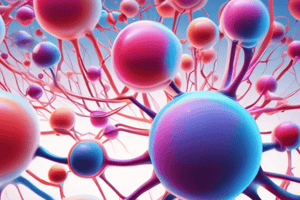Podcast
Questions and Answers
What is the normal range for plasma osmolality?
What is the normal range for plasma osmolality?
- 280 – 294 mOsm/kg (correct)
- 320 – 350 mOsm/kg
- 250 – 270 mOsm/kg
- 300 – 320 mOsm/kg
Which type of fluid imbalances is characterized by changes in water accompanied by proportional changes in [NaCl]?
Which type of fluid imbalances is characterized by changes in water accompanied by proportional changes in [NaCl]?
- Isotonic imbalances (correct)
- Osmolar imbalances
- Hypotonic imbalances
- Hypertonic imbalances
What mechanism primarily leads to isotonic fluid imbalances?
What mechanism primarily leads to isotonic fluid imbalances?
- Proportional alterations in NaCl and water (correct)
- Changes in acid-base levels
- Excessive fluid retention only
- Inconsistent Na+ concentrations
What is the primary cause of isotonic fluid loss in conditions like hemorrhage?
What is the primary cause of isotonic fluid loss in conditions like hemorrhage?
Which of the following is NOT a common example of isotonic excess?
Which of the following is NOT a common example of isotonic excess?
What happens to cells in a hypotonic solution?
What happens to cells in a hypotonic solution?
Which condition is associated with hypernatremia?
Which condition is associated with hypernatremia?
Which symptom is commonly associated with hyperkalemia?
Which symptom is commonly associated with hyperkalemia?
What is the primary cause of metabolic acidosis?
What is the primary cause of metabolic acidosis?
What does alkalosis indicate in the body?
What does alkalosis indicate in the body?
Which of the following symptoms would be expected in a patient with hypocalcemia?
Which of the following symptoms would be expected in a patient with hypocalcemia?
What is a common cause of respiratory acidosis?
What is a common cause of respiratory acidosis?
Which ion plays a critical role in determining membrane excitability?
Which ion plays a critical role in determining membrane excitability?
Which of the following best describes the role of the carbonic acid-bicarbonate buffering system?
Which of the following best describes the role of the carbonic acid-bicarbonate buffering system?
What is a potential complication of prolonged hypercalcemia?
What is a potential complication of prolonged hypercalcemia?
Study Notes
Edema
- Review focused on fluid imbalance and its implications on cellular function.
Sodium, Chloride, and Water Balance
- Water imbalances arise from changes in osmotic gradients, influenced primarily by NaCl concentrations.
- Tonicity refers to effective osmolality, differentiating it from osmolarity.
- Normal plasma osmolality ranges from 280 to 294 mOsm/kg.
Water and Solute Imbalances
- Isotonic: Equal change in water and NaCl; normal extracellular NaCl; no cellular shape change. Common examples include hemorrhage and kidney failure.
- Hypotonic: Decreased extracellular NaCl leading to cell swelling; linked with hyponatremia and water intoxication.
- Hypertonic: Elevated extracellular osmolality causing cell shrinkage; associated with hypernatremia and water deficit conditions like hyperglycemia.
Potassium and Calcium Balance
- Involves conditions like hypokalemia, hyperkalemia, hypocalcemia, and hypercalcemia, impacting muscle and cardiac function.
- Changes in potassium levels can lead to muscle weakness, heart dysrhythmias, or seizures.
- Electrocardiogram (ECG) changes may be observed with potassium serum levels at 5.0 mEq/L, often due to renal failure or hemolysis.
Hormonal Regulation
- Calcium imbalance is regulated by parathyroid hormone (PTH).
- Common causes of hypocalcemia include hyperparathyroidism, bone metastases, nutritional deficiencies, and inadequate absorption.
Acid-Base Imbalances
- Occurs when blood acidity or basicity changes beyond normal buffering capacity.
- Two primary types: acidosis (increased H+ concentration) and alkalosis (decreased H+ concentration).
Important Terms
- Acidosis: Increased H+ or base loss results in decreased pH.
- Alkalosis: Decreased H+ or base excess results in increased pH.
- Respiratory-related: Imbalances caused by respiratory disorders.
- Metabolic-related: Imbalances resulting from metabolic (renal) disorders.
Carbonic Acid-Bicarbonate Buffering System
- Acts to regulate blood pH by balancing hydrogen ions and carbon dioxide through respiratory and renal systems.
Common Causes of Acid-Base Imbalances
- Acidosis: Caused by respiratory center depression or airway obstruction.
- Alkalosis: Resulting from conditions like alveolar hyperventilation.
Clinical Manifestations
- Calcium imbalance may lead to symptoms ranging from asymptomatic to neuromuscular excitability, seizures, or complications like kidney stone formation.
Studying That Suits You
Use AI to generate personalized quizzes and flashcards to suit your learning preferences.
Related Documents
Description
This quiz covers key concepts from Chapter 3 of McCance & Huether's 8th edition textbook focusing on the cellular environment and alterations, including an in-depth look at edema. Gain a deeper understanding of pathophysiological changes and their implications in health science. Prepare to test your knowledge on these essential topics.




